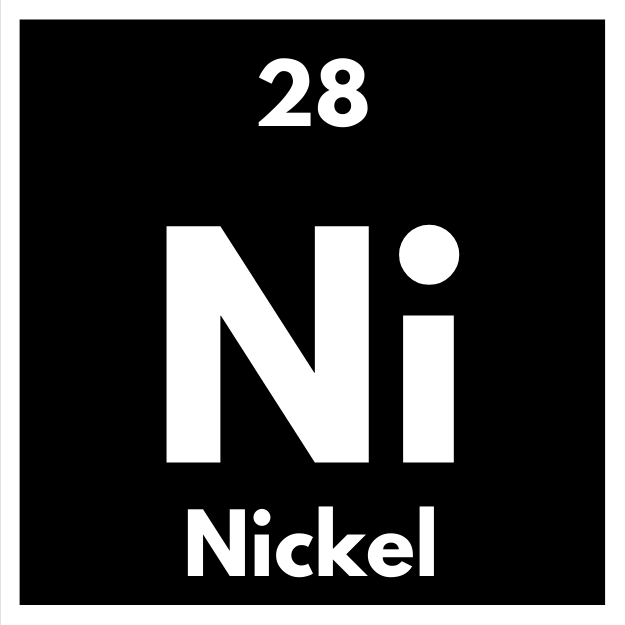Nickel is a chemical element with symbol Ni and atomic number 28. It is a silvery-white lustrous metal with a slight golden tinge. Nickel is a hard and ductile transition metal.
Symbol: Ni
Atomic number: 28
Atomic mass: 58.6934 u
Electron configuration: [Ar] 3d⁸4s²
CAS ID: 7440-02-0
Melting point: 1,455 °C
Discoverer: Axel Fredrik Cronstedt
List of facts
Nickel is a chemical element with symbol Ni
Nickel has the atomic number 28.
It is a silvery-white lustrous metal with a slight golden tinge
Use of nickel has been traced as far back as 3500 BCE
Nickel is the fifth most abundant element on Earth.
The element’s name comes from a mischievous sprite of German miner mythology, Nickel
An economically important source of nickel is the iron ore limonite, which is often 1–2% nickel.
Nickel was first isolated and classified as an element in 1751 by Axel Fredrik Cronsted
Major production sites include the Sudbury region, Canada, New Caledonia in the Pacific, and Norilsk, Russia.
Nickel is one of four elements (the others are iron, cobalt, and gadolinium) that are ferromagnetic at about room temperature.
About 68% of world production is used in stainless steel.
Natural nickel is composed of five stable isotopes, 58Ni, 60Ni, 61Ni, 62Ni and 64Ni
58Ni is the most abundant at 68.077% natural abundance
Nickel can be a skin allergen in some people, so iron replaced it in coins.
Adding nickel to glass gives it a green color.
On Earth, nickel occurs most often in combination with sulfur and iron in pentlandite
Its is also found in combination with sulfur in millerite, with arsenic in the mineral nickeline, and with arsenic and sulfur in nickel galena
Nickel is commonly found in iron meteorites as the alloys kamacite and taenite.
Nickel in meteorites was first detected in 1799 by Joseph-Louis Proust, a French chemist who then worked in Spai
The bulk of nickel is mined from two types of ore deposits. laterite and garnierite.
Indonesia and Australia have the biggest estimated reserves, at 43.6% of world total
Most of the nickel on Earth is believed to be in Earth’s outer and inner cores
The nickel deposits of New Caledonia, discovered in 1865, provided most of the world’s supply between 1875 and 1915.
99.9% nickel five-cent coins were struck in Canada during non-war years from 1922 to 1981
The US nickel coin contains 0.04 ounces (1.1 g) of nickel
Coins still made with nickel alloys include one- and two-euro coins, 5¢, 10¢, 25¢, 50¢, and $1 U.S. coins, and 20p, 50p, £1, and £2 UK coins
From 2012 on the nickel-alloy used for 5p and 10p UK coins was replaced with nickel-plated steel.
An estimated 2.7 million tonnes of nickel per year are mined worldwide
Indonesia (1,000,000 t), the Philippines (370,000 t), Russia (250,000 t), New Caledonia (France) (190,000 t), Australia (160,000 t) and Canada (130,000 t) are the largest producers of Nickel as of 2021
Nickel is known to play an important role in the biology of some plants, bacteria, archaea, and fungi
Nickel’s melting point is very high at 1455 degrees Celsius,
Nickel is a good conductor of electrical current and can absorb and transfer heat very easily.
Nickel is carcinogenic in humans.
Between 10 and 20% of people are sensitive to nickel and suffer dermatitis from skin contact with the metal.
Nickel Properties
Nickel in the periodic table |
|||||||||||||||
|---|---|---|---|---|---|---|---|---|---|---|---|---|---|---|---|
| Atomic number (Z) | 28 | ||||||||||||||
| Group | group 10 | ||||||||||||||
| Period | period 4 | ||||||||||||||
| Block | d-block | ||||||||||||||
| Electron configuration | [Ar] 3d8 4s2 or [Ar] 3d9 4s1 | ||||||||||||||
| Electrons per shell | 2, 8, 16, 2 or 2, 8, 17, 1 | ||||||||||||||
Physical properties |
|||||||||||||||
| Phase at STP | solid | ||||||||||||||
| Melting point | 1728 K (1455 °C, 2651 °F) | ||||||||||||||
| Boiling point | 3003 K (2730 °C, 4946 °F) | ||||||||||||||
| Density (near r.t.) | 8.908 g/cm3 | ||||||||||||||
| when liquid (at m.p.) | 7.81 g/cm3 | ||||||||||||||
| Heat of fusion | 17.48 kJ/mol | ||||||||||||||
| Heat of vaporization | 379 kJ/mol | ||||||||||||||
| Molar heat capacity | 26.07 J/(mol·K) | ||||||||||||||
Vapor pressure
|
|||||||||||||||
Atomic properties |
|||||||||||||||
| Oxidation states | −2, −1, 0, +1,[2] +2, +3, +4[3] (a mildly basic oxide) | ||||||||||||||
| Electronegativity | Pauling scale: 1.91 | ||||||||||||||
| Ionization energies |
|
||||||||||||||
| Atomic radius | empirical: 124 pm | ||||||||||||||
| Covalent radius | 124±4 pm | ||||||||||||||
| Van der Waals radius | 163 pm | ||||||||||||||
|
|
|||||||||||||||
Other properties |
|||||||||||||||
| Natural occurrence | primordial | ||||||||||||||
| Crystal structure | face-centered cubic (fcc) | ||||||||||||||
| Speed of sound thin rod | 4900 m/s (at r.t.) | ||||||||||||||
| Thermal expansion | 13.4 µm/(m⋅K) (at 25 °C) | ||||||||||||||
| Thermal conductivity | 90.9 W/(m⋅K) | ||||||||||||||
| Electrical resistivity | 69.3 nΩ⋅m (at 20 °C) | ||||||||||||||
| Magnetic ordering | ferromagnetic | ||||||||||||||
| Young’s modulus | 200 GPa | ||||||||||||||
| Shear modulus | 76 GPa | ||||||||||||||
| Bulk modulus | 180 GPa | ||||||||||||||
| Poisson ratio | 0.31 | ||||||||||||||
| Mohs hardness | 4.0 | ||||||||||||||
| Vickers hardness | 638 MPa | ||||||||||||||
| Brinell hardness | 667–1600 MPa | ||||||||||||||
| CAS Number | 7440-02-0 | ||||||||||||||

